- Continue Shopping
- Your Cart is Empty
Maker Club
I had a great time last term helping with some school-based Maker Club's around town.
Dunlop PS sold t-Shirts to bring me in for a fully facilitated club. That means I led the club members through complete projects and supplied all the materials. There was a Primary Club for grades 1, 2 and 3 and a Junior Club for grades 4, 5, 6. Each club was held over a 25 minute recess so we generally did one project over two weeks. A lot of prep went in to making sure the kids spent most of their time working with the project and not waiting for components or instruction. We had 18 students in the Primary Club and 25 students in the Junior Club. We were successful working with such large groups because of the wonderful parent and teacher volunteers who came in to help! With the volunteers we were able to have the students work in small groups so they had help on hand to answer questions and didn't have to wait for me to make it to the table.
We all had a lot of fun. We learnt some new skills and worked with new tools. Some kids found some new areas of expertise that they were able to help others with. The Primary Club and Junior Club worked on similar projects with either different components or different levels of prep by me before the club began. Here is some of their work:

I have also been volunteering with the Maker Club at my son's school, JH Putman PS . My son just started here this year. JH Putman is a middle school that has a lot of extracurricular activities that are run by staff, students and volunteers. This year, JH Putman has started transforming their old darkroom into a makerspace and I have volunteered to come and supervise the makerspace once a week. When we started out the year we had some computers and a handful of MakeyMakey's and we were waiting for more equipment to come. My son convinced a few of friends to come join him in the makerspace and we started playing with the MakeyMakey's. Some of the older kids already had a cool game controller going, but I needed something to get the new grade 6 kids involved. I brought in a few different project ideas from Make that involved hooking the MakeyMakey up to Scratch. They spent a week or two modifying the "Door Knocker of Doom" to work with a foot pedal. And then I left them this:

I fully admit that by this point I was experimenting with how little information I could give them and have them get a project to work. And by the time I came back the week after, we had this:

It's not hooked up to the MakeyMakey in this photo - but they had it hooked up and working. We experimented with adding new notes. I love it. Since then, we've had a fantastic donation of equipment to the makerspace and they are interested in learning how to solder and, of course, de-solder. I can't wait to see where this group heads this year.
Break and Make Workshop
One of my favourite workshops is the Break and Make. The title here explains it all. First, we "break". We put our safety glasses on, I hand out some basic consumer electronics, and away we go.
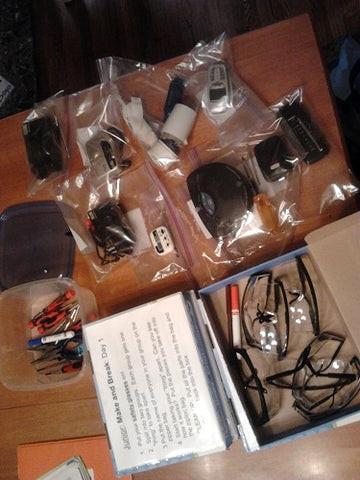
A successful Break and Make requires some prep work ahead of time. Before the workshop starts I take the time to:
- Look at every item we're going to "break" and make sure the screws will turn
- Cut off power cords and remove any batteries
- Start anything that needs to be pried open or needs special tools
- Package each item with the screwdriver they will need to get started
My goal is for the kids to be successful as they start to take things apart. I always pack a box of extra tools they'll need as they work their way in, but I make sure they can get started right away.
Safety first! Safety glasses go on before the packages are handed out. And safety glasses must stay on! It's hard to resist "prying" and those eyes need to be covered! Even if they are wearing glasses, safety glasses are a must. You'll feel much better when those keys start flying off the keyboards.
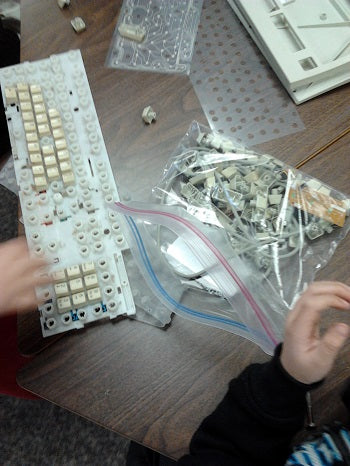
Good items to take apart are ones you use every day. Radios. Hair dryers. Keyboards are easy and very satisfying for the younger kids. Some electronics are not safe to take apart – TV's, monitors, anything that could shatter or hold a charge. As the kids are working, stop by and talk about what they're seeing. Ask questions – what could this do? What is this for?

Some kids will need encouragement to keep going. Some kids will be worried about "breaking" the item beyond repair. Others will take the "breaking" very literally. No – I don't take hammers to a Break and Make! Be prepared to step in and help when screws are tight or difficult to find.

Once we get everything mostly apart, it's time to start the art. I hand out pieces of foam core. I usually cut a full size poster board into smaller pieces. Heavy cardboard works too. You need something stiff to hold the heavier pieces and a lot of the pieces can actually be poked through the board.

The usual craft supplies are important – tape, markers, scissors, glue. I always take a couple of different types of glue and a hot glue gun. Tape and a glue stick will work for the majority of the artwork, but hot glue will stick a heavier item down without an extended dry time.
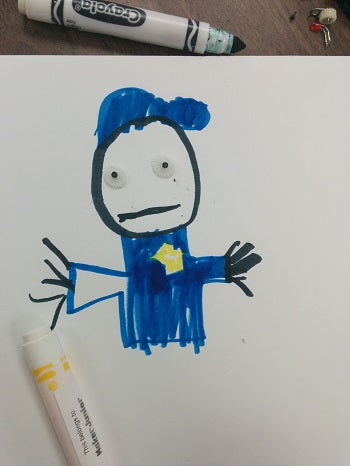
Resist the temptation to remove safety glasses! If someone is still taking apart or cutting, everyone needs to be wearing safety glasses.
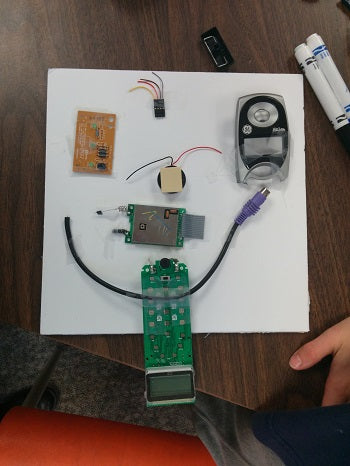
Have fun! This is about exploration and play with learning along the way. It's okay if something breaks, that's the point.
Thanks to the Dunlop PS Primary Maker Club for the great art!
Projects for Kids at Maker Faire 2013 - New York
( More on Maker Faire at Maker Junior at Maker Faire 2013 - New York )
There were over 650 exhibitors at the Maker Faire in New York City. Many thanks to Jeff at Stem Design Labs for helping out at the booth so I could get away.
The Maker Junior booth was in the Young Maker's tent. Around us were lots of schools demonstrating what their students were doing. The United Nations International School is a private school in New York that has a maker space called the CoLaboratory. They were showing some cardboard quiz games that I really liked.

In the booth behind us, the Marymount School was displaying some student projects that included clothing made from recycled materials. Take a close look at this project to see what the flag is made from.
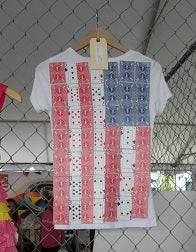
Farther back in the tent was the Brooklyn Robot Foundry. They have afterschool classes, summer sessions and birthday parties for kids to build robots. This robot, that was built at one of their summer sessions, gives free hugs!

My son and I also had a chance to talk with Mike Carroll, who's created a character and written a book about Dewey Mac, a 12-yr old detective who creates gadgets. Mike was giving away Dewey Mac's Lie Detector kits. You can be sure we're going to try this out.

Another booth we really liked was TakeItApart from Rochester, NY. Have you ever seen the prism from inside a camera before? I've got an old film camera that we'll be taking apart at our Break and Make class on October 22.

We are also looking forward to playing around with some Duct Tape Bling. I found some tie-dyed patterned duct tape so we're ready to go.

This is only a small part of what there was available to see and make at the Faire. You could make LED Pinnies at the Make booth or a marshmallow gun out of PVC piping. There was a fantastic Iron Man costume, Spin Bots, Little Bits workshops, sewing, woodworking, welding, and coffee pouring robots. We even saw a golf club that was turned into an electric guitar. It was inspiring to walk around and see the creativity and imagination at work. It's worth taking the time to find out if there is a Maker Faire happening near you!
Inventor's Fair
Last weekend I had a chance to go the Princess Auto Parts Inventor's Fair here in Ottawa. There is an old English proverb that says "Necessity is the mother of invention". I saw that in action at the Inventor's Fair on Saturday.
This is the Mosquito Cemetery. It uses the carbon dioxide generated by the humans and animals inside a building to attract mosquitoes to a trap on the outside of the a building. No additional carbon dioxide or fuel canisters required.

This is a rake for a gravel path:

I spoke with Wendy van der Horn. Wendy's husband, Tim, is a prolific inventor. Tim has invented a Wind Powered Generator with two turbines that can produce more energy from less wind. He was also presenting the Can Hoist and a hitch removal tool.

I also had a chance to speak to several members of the Inventors Association (Ottawa). The Inventors Association has been meeting since 1986 and draws members from all over Eastern Ontario. It's open to all adults who are interested in inventing or helping inventors succeed. It's open to adults only because signing a NDA (Non-Disclosure Agreement) is a condition of membership. They are interested in helping inspire kids, though, and all of the inventors at the fair were happy to talk about their inventions.
My favorite invention at the fair was Tim van der Horn's hitch removal tool. Take a look at this picture, can you see how it works?

Soft Circuit Prototypes
I've mentioned conductive paint before, but did you know there's conductive thread too?
E-textiles have been around for a while. Leah Buechley, an associate professor at MIT and director of the High-Low Tech Group, is a leading expert in this area and has developed the super-cool Lilypad Arduino toolkit. She's got a great tutorial online using basic components and I thought I'd give it a try.
I made this robot using a snap as a switch.

And my favourite – the component dude/tte! This was made by my 11-year old helper. The hook and eye works really well as a switch for this example, and the battery is hidden behind the figure.

Next step, finding more kids to try this out with. I wonder what they'll make?
